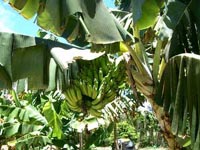Resource Library
Plant of the Week: Banana
The University of Arkansas System Division of Agriculture does not promote, support or recommend plants featured in "Plant of the Week." Please consult your local Extension office for plants suitable for your region.
Plant of the Week
Banana
Latin: Musa x paradisiacal
For supper, I had status food - cherry Jell-O with bananas. Today, we don't think of either of these lowly foods as anything special, but both became part of the mainstream American diet during the 20th century.
Electric refrigeration made Jell-O a reality while modern transportation moved bananas from their tropical homeland to the most distant corners of the country. Originally, only seaport towns had bananas.
Bananas are Old World herbs that are grown in all parts of the tropics that have sufficient rainfall. The banana of commerce in North America is Musa x paradisiaca, a sterile, usually triploid (three sets of chromosomes instead of a pair), seedless hybrid. Most of our bananas come from Central America where large, multinational corporations control all aspects of production, marketing and distribution.
The edible banana is an herbaceous perennial that grows from a rhizomatous crown. The banana stem, which can grow to 20 feet tall with large, tattered, oar-shaped leaves, is actually a cluster of leaf petioles called a pseudostem. In a tropical environment with good growing conditions, these pseudostems send forth a banana flower after about 10 months of growth.
Describing a banana flower is difficult to do in a family newspaper. The terminal bud on the ever-lengthening inflorescence is usually a maroon, cone-shaped affair about six inches across. Bananas form in a bunch behind the bud and take about 100 days from flowering until the fruit are ripe. The stalks are harvested green and ripened at the port of entry by exposing them to ethylene gas, a natural plant growth hormone involved in fruit ripening.
When a pseudostem flowers, it dies. When the banana bunch is harvested, the pseudostem is cut to the ground to encourage new stems to develop.
The first shipment of bananas to the United States occurred in 1804 when Capt. John Chester sent 30 bunches to Boston aboard the schooner Reynard. As the 19th century progressed, bananas became more commonplace with New Orleans becoming the principle port of entry for the fruit by 1890.
U. P. Hedrick, a horticulturist who grew up in the wilds of the Upper Peninsula of Michigan, described in his autobiography the excitement he remembered when trains began delivering bananas to his local store in the 1890s.
Tulsa residents about the same time began receiving shipments of bananas, but their initial reaction was lukewarm until someone explained they had to be peeled before they were eaten. Today, bananas are the most popular fruit in the nation.
Bananas are not commercially produced in the continental U.S. because they require a completely frost free environment. But ornamental banana plantings are becoming more common as gardeners go for a more tropical look in their gardens.
Banana plants can be saved from year to year by cutting the foliage off and saving the main trunk. The trunk can be wrapped in a tarp and stored like so much cord wood in any location where it will not freeze. Plant it outside after the danger of frost is past in a location protected from strong winds. Water liberally during the summer.
By: Gerald Klingaman, retired
Extension Horticulturist - Ornamentals
Extension News - January 23, 2004
The University of Arkansas System Division of Agriculture does not maintain lists of retail outlets where these plants can be purchased. Please check your local nursery or other retail outlets to ask about the availability of these plants for your growing area.
